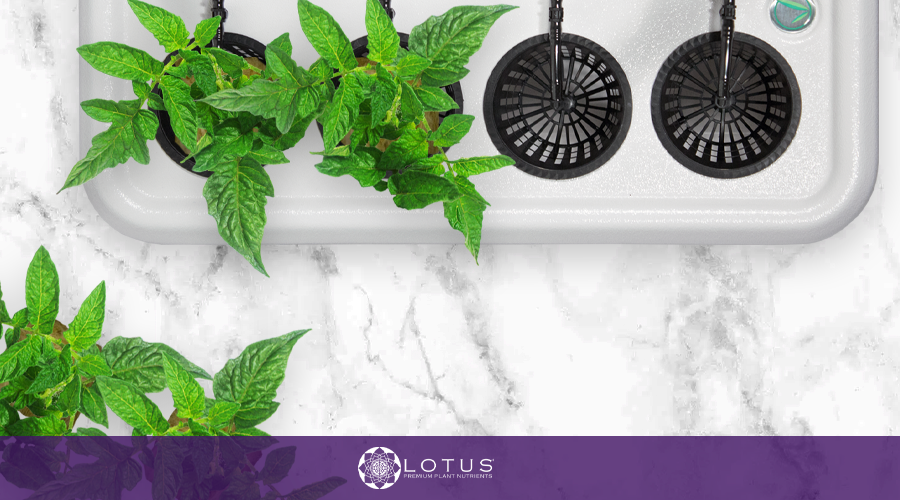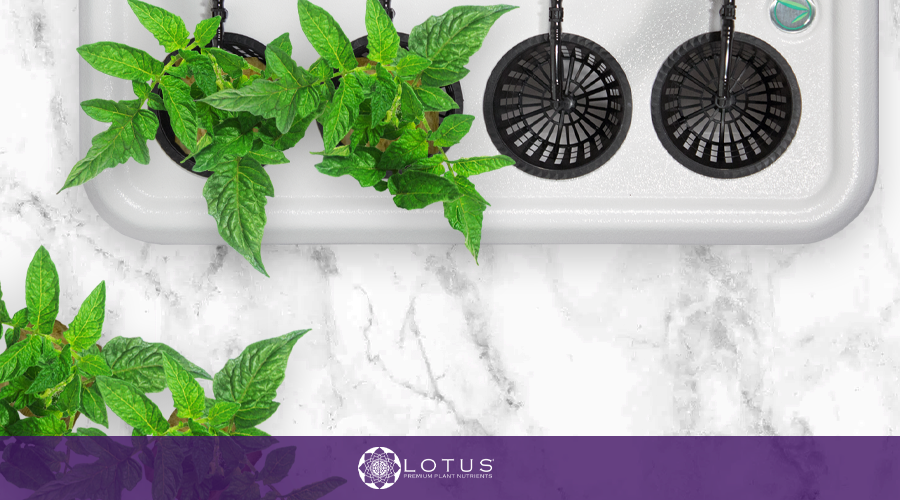
Choosing the Best Hydroponic System for Growing Cannabis

Hydroponics 101: The Ultimate Guide to Growing Cannabis Plant Indoors
As cannabis cultivation continues to evolve, more and more growers are turning to hydroponic systems to maximize yields and produce high-quality indoor cannabis plants. Hydroponics, a soilless cultivation technique, offers several advantages over traditional soil-based methods, including faster growth, increased control over nutrient intake, and optimal water usage.
If you are ready, let's explore the benefits of hydroponic systems for growing cannabis indoors and provide essential tips to help you succeed in your hydroponic cannabis garden.
Growing Cannabis Hydroponically
Hydroponics is a method of growing plants without soil, using a nutrient-rich water solution to deliver essential elements directly to the roots. This technique allows for precise control over nutrient levels, pH balance, and water content, ensuring that cannabis plants receive the ideal conditions for growth. Common hydroponic systems for cannabis include deep water culture (DWC), nutrient film technique (NFT), and aeroponics.
Advantages of Hydroponic Systems for Cannabis
Faster Growth: Hydroponic systems promote accelerated growth rates compared to soil-based cultivation. With direct access to essential nutrients and oxygen, cannabis plants can focus their energy on vegetative and flowering stages, resulting in shorter overall growth cycles.
Increased Yields: By fine-tuning nutrient delivery and environmental conditions, hydroponics enables growers to optimize plant growth and maximize yields. Proper management can achieve larger, denser buds and a higher overall harvest.
Enhanced Control: Hydroponics precisely controls essential factors such as pH, nutrient concentration, and water content. This level of control minimizes the risk of nutrient deficiencies, pH imbalances, and water-related issues, leading to healthier and more resilient cannabis plants.
Choosing the Right Cannabis Varieties for Hydroponics
When selecting cannabis strains for hydroponic cultivation, consider their growth characteristics and suitability for indoor environments. Look for strains known for their vigorous growth, disease resistance, and compatibility with hydroponic systems. Indica-dominant or hybrid strains are often preferred due to their compact size and shorter flowering periods, making them more manageable in limited indoor spaces.
Setting Up a Hydroponic Cannabis Garden
Choosing the Right System:
Consider available space, budget, and personal preferences when selecting a hydroponic system. Research various systems and determine which aligns best with your needs and goals.
Nutrient Management:
Invest in high-quality hydroponic nutrients specifically formulated for cannabis cultivation. Follow the manufacturer's instructions and monitor nutrient levels regularly to ensure optimal plant health.
pH and EC Monitoring:
Regular monitoring of pH levels and electrical conductivity (EC) is essential in hydroponics. pH levels outside the optimal range can lead to nutrient imbalances and affect plant growth. Use pH testing kits or meters to measure the pH of the nutrient solution and adjust it using pH up or down solutions. EC meters help measure the concentration of nutrients in the solution, allowing you to adjust the nutrient strength accordingly.
Lighting Considerations:
Proper lighting is crucial for cannabis plants in hydroponic systems. High-intensity discharge (HID) lights, such as metal halide (MH) for vegetative growth and high-pressure sodium (HPS) for flowering, are commonly used in indoor cannabis cultivation. Light-emitting diode (LED) grow lights are also gaining popularity due to their energy efficiency and customizable spectral output. Ensure the lights provide the right intensity and spectrum for each growth stage to optimize photosynthesis and promote healthy plant development.
Environmental Control:
Maintaining optimal environmental conditions is vital for hydroponic cannabis cultivation. Temperature, humidity, and ventilation should be carefully managed to prevent mold, mildew growth, and pest infestations. Provide adequate air circulation and ventilation to maintain fresh air exchange and prevent stagnant conditions. Use humidifiers or dehumidifiers to control humidity levels, keeping them within the optimal range for cannabis growth (around 50-60% during the vegetative stage and around 40-50% during the flowering stage). Monitor and adjust temperature levels to ensure they fall within the appropriate range for your specific strain.
Training and Pruning Techniques:
To optimize yields and manage the canopy, employing training and pruning techniques is essential in hydroponic cannabis cultivation. Techniques such as low-stress training (LST), topping, and defoliation can help control plant height, promote lateral branching, and improve light penetration throughout the canopy. These techniques also aid in maximizing bud development and airflow, reducing the risk of mold or mildew formation.
Watering and Nutrient Delivery Methods:
Hydroponic systems require careful attention to watering and nutrient delivery. Depending on your chosen system, you may need to establish a watering schedule or use automated irrigation systems to ensure consistent moisture levels. It's crucial to avoid overwatering, as this can lead to root rot. Monitor the water level in your hydroponic system regularly and adjust as necessary. Additionally, consider incorporating beneficial microbial products or supplements to enhance nutrient uptake and root health.
Integrated Pest Management (IPM):
Even in a controlled indoor environment, pests can still threaten hydroponically grown cannabis plants. Implementing an Integrated Pest Management (IPM) strategy is vital to prevent and address pest issues. This includes regular scouting for pests, implementing physical barriers, using organic pest control methods (e.g., neem oil, insecticidal soaps), and introducing beneficial insects to combat pests naturally.
Water Quality and Filtration:
The quality of water used in hydroponics can significantly impact plant health and system longevity. It's important to use clean, pH-balanced water with low levels of contaminants. Consider using reverse osmosis (RO) water or investing in water filtration systems to remove impurities, chemicals, and excess minerals that can interfere with nutrient uptake or cause pH fluctuations.
Monitoring and Record-Keeping:
Maintaining accurate records of your hydroponic cannabis garden is valuable for future reference and troubleshooting. Keep track of essential parameters such as nutrient concentrations, pH levels, temperature, humidity, lighting schedules, and any adjustments or changes made. This documentation will help you identify patterns, diagnose issues, and refine your cultivation practices over time.
Harvesting and Curing:
Once your cannabis plants have reached maturity, it's time to harvest and cure the buds properly. Harvesting should be done when the trichomes (resin glands) peak, which can be determined using a jeweler's loupe or microscope. After harvest, carefully trim the buds and hang them in a cool, dark, and well-ventilated space to dry. Once dried, cure the buds in glass jars, burping them periodically to release excess moisture and promote the development of desired flavors and aromas.
Continuous Learning and Adaptation:
Hydroponic cannabis cultivation is a dynamic and evolving practice. Stay informed about the latest advancements, techniques, and research in the field. Engage with online forums, join cannabis cultivation communities, and attend workshops or conferences to learn from experienced growers. By staying curious, adaptable, and open to new ideas, you can refine your skills and achieve even greater success in your hydroponic cannabis garden.
Common Challenges and Troubleshooting
Nutrient Imbalances: Monitor nutrient levels regularly and adjust accordingly to avoid nutrient imbalances. Symptoms such as yellowing leaves or stunted growth can indicate deficiencies or excesses of specific nutrients.
Pest Control: Despite the absence of soil, hydroponic systems can still be susceptible to pests. Implement preventive measures such as regular inspections, proper sanitation, and organic pest control methods to keep pests at bay.
Root Health: Inspect your plant's roots regularly for signs of root rot, which can occur if the roots are constantly submerged or lack sufficient oxygen. Maintain proper water levels and oxygenation to promote healthy root development.
Successful hydroponic cannabis cultivation requires patience, attention to detail, and a willingness to learn and adapt. Continuously educate yourself on best practices, stay vigilant in monitoring your plants, and don't be afraid to experiment and make adjustments. With dedication and a well-executed hydroponic system, you can achieve exceptional results in growing cannabis indoors.
Finding the Perfect Blend: Exploring the Best All-in-One Cannabis Nutrient
Cultivating cannabis is both an art and a science, requiring careful attention to detail and a deep understanding of the plant's nutritional needs. One crucial aspect of successful cannabis cultivation is providing nutrients to support healthy growth and maximize yield. In recent years, all-in-one cannabis nutrient solutions have gained popularity among growers for their convenience and effectiveness.
The Quest for Perfection: Finding the Best All-in-One Nutrient for Cannabis
Before delving into the best all-in-one cannabis nutrient solutions, it's essential to understand the specific nutritional requirements of the cannabis plant. Just like any other plant, cannabis relies on a balanced supply of essential macronutrients (nitrogen, phosphorus, and potassium) as well as secondary nutrients (calcium, magnesium, and sulfur) and micronutrients (iron, zinc, copper, etc.).
The ratios and concentrations of these nutrients can vary depending on the plant's growth stage—vegetative, flowering, and fruiting. Achieving the right nutrient balance is critical to avoiding deficiencies or excesses that can stunt growth, reduce yields, and compromise the quality of the final product.
Advantages of All-in-One Cannabis Nutrient
All-in-one cannabis nutrient solutions have gained traction due to their simplicity and efficiency. These solutions are designed to provide a balanced blend of nutrients in a single product, streamlining the feeding process for novice and experienced growers.
Here are some advantages to keep in mind when considering all-in-one nutrient solutions:
Convenience: All-in-one nutrients simplify the feeding regimen, eliminating the need to mix multiple products.
Nutrient Balance: Reputable all-in-one solutions are formulated with the right ratios of nutrients to support cannabis growth through different stages.
Consistency: Since the nutrient composition is pre-mixed, growers can expect more consistent plant health and yield results.
Cost-Effective: While the initial investment might seem higher, the overall cost can be lower than purchasing individual nutrients.
Exploring Lotus Nutrients: Elevating Cannabis Cultivation with Innovative Nutrition Solutions
Cannabis cultivation has come a long way, evolving from traditional practices to a science-driven endeavor that seeks to maximize yield and quality. One player that has made a mark in this field is Lotus Nutrients, a company that offers a range of nutrient products designed to cater to the diverse needs of cannabis plants. In this article, we'll take a closer look at Lotus Nutrients and how their products are making a difference in the world of cannabis cultivation.
A Brief Overview of Lotus Nutrients
Founded on a passion for cultivating the finest cannabis crops, Lotus Nutrients has positioned itself as a provider of premium-quality nutrient solutions that combine scientific expertise with practical application. The company aims to empower growers with products that offer optimal nutrition throughout the entire growth cycle, leading to healthy plants and bountiful harvests.
Key Features and Benefits of Lotus Nutrients Products
Customizable Formulas: One standout feature of Lotus Nutrients is its approach to customization. They offer a variety of base nutrients and supplements that can be tailored to specific strains, growth stages, and cultivation methods. This level of customization allows growers to fine-tune their feeding regimen to meet the unique needs of their plants.
Full Spectrum of Nutrients: Lotus Nutrients products are formulated to provide a comprehensive range of macronutrients, micronutrients, and trace elements. This holistic approach ensures that plants receive all the essential components for robust growth, vibrant flowering, and resinous bud production.
Eco-Friendly Focus: Lotus Nutrients is dedicated to sustainability and environmentally friendly practices. Many of their products are designed to be pH-stable, reducing the need for frequent pH adjustments. Their nutrient solutions are also designed to minimize waste and runoff, promoting responsible water usage.
Flush-Free Technology: Some Lotus Nutrients products incorporate a flush-free technology that helps prevent nutrient build-up and salt accumulation in the growing medium. This technology contributes to healthier plants and cleaner final products.
Ease of Use: Lotus Nutrients prides itself on user-friendly products that simplify feeding. Whether beginners or experienced cultivators, growers can find their nutrient regimens straightforward.
Lotus Nutrients Product Line
Lotus Nutrients offers a range of products designed to cover the complete growth cycle of cannabis plants, from seedling to harvest. Some of their notable products include:
Lotus Nutrients Pro Series Grow, Bloom, and Boost: This trio of products covers the essential nutrient needs of cannabis plants during vegetative growth, flowering, and final ripening stages.
Lotus Nutrients Boost: Designed to enhance flowering and resin production, Boost is a supplement that aids in maximizing yields and potency.
Lotus Nutrients Cal-Mag: An essential supplement that provides additional calcium and magnesium, crucial for preventing deficiencies and maintaining plant health.
Lotus Nutrients Start: A product formulated to support the early stages of plant growth, providing a solid foundation for healthy development.
Lotus Nutrients has carved out a niche in the cannabis cultivation industry by offering versatile, customizable, and eco-conscious nutrient solutions. Their commitment to quality, innovation, and sustainability has resonated with growers looking to achieve exceptional results while minimizing environmental impact. As the cannabis cultivation landscape continues to evolve, Lotus Nutrients is a prime example of how science-driven approaches to plant nutrition can elevate the art of growing cannabis.
Whether you're a seasoned cultivator or just starting, exploring Lotus Nutrients' product line could be a step toward achieving your cannabis cultivation goals.
